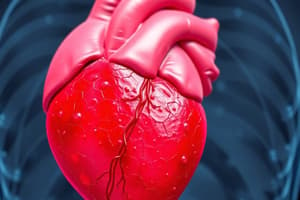Podcast
Questions and Answers
What does the presence of eosinophilic, homogenous material in a biopsy suggest in this context?
What does the presence of eosinophilic, homogenous material in a biopsy suggest in this context?
- Infectious myocarditis
- Amyloid deposition (correct)
- Malignant transformation
- Chronic inflammation
Which staining technique reveals apple green birefringence in this case?
Which staining technique reveals apple green birefringence in this case?
- Gram stain
- Hematoxylin and eosin stain
- Masson's trichrome stain
- Congo Red special stain (correct)
Which of the following conditions is characterized by endomyocardial fibrosis?
Which of the following conditions is characterized by endomyocardial fibrosis?
- Endocardial fibroelastosis
- Arrhythmogenic right ventricular cardiomyopathy
- Restrictive cardiomyopathy
- Loeffler endomyocarditis (correct)
What is the most likely conclusion about the finding of salmon pink staining?
What is the most likely conclusion about the finding of salmon pink staining?
Which condition is primarily associated with myeloproliferative disorders?
Which condition is primarily associated with myeloproliferative disorders?
What type of amyloidosis is primarily caused by multiple myeloma?
What type of amyloidosis is primarily caused by multiple myeloma?
Which of the following is NOT a characteristic of amyloid pathology?
Which of the following is NOT a characteristic of amyloid pathology?
Which statement accurately describes primary systemic amyloidosis?
Which statement accurately describes primary systemic amyloidosis?
Which type of cardiomyopathy is associated with endomyocardial fibrosis?
Which type of cardiomyopathy is associated with endomyocardial fibrosis?
What distinguishes localized amyloidosis from systemic amyloidosis?
What distinguishes localized amyloidosis from systemic amyloidosis?
What is a common symptom of cardiac amyloidosis?
What is a common symptom of cardiac amyloidosis?
Which histological finding is characteristic of cardiac amyloidosis?
Which histological finding is characteristic of cardiac amyloidosis?
What causes the impaired filling during diastole in restrictive cardiomyopathy?
What causes the impaired filling during diastole in restrictive cardiomyopathy?
A biopsy revealing amorphous deposits between myocardial fibers is indicative of which condition?
A biopsy revealing amorphous deposits between myocardial fibers is indicative of which condition?
What is the common consequence of increased stiffness of the left ventricle in restrictive cardiomyopathy?
What is the common consequence of increased stiffness of the left ventricle in restrictive cardiomyopathy?
Which condition is often mistaken for constrictive pericarditis due to similar symptoms?
Which condition is often mistaken for constrictive pericarditis due to similar symptoms?
Which type of stain is used to visualize amyloid deposits in tissues?
Which type of stain is used to visualize amyloid deposits in tissues?
What is one of the diagnostic markers for AL amyloidosis?
What is one of the diagnostic markers for AL amyloidosis?
Which condition in children is characterized by endomyocardial fibrosis and is often a tropical disease?
Which condition in children is characterized by endomyocardial fibrosis and is often a tropical disease?
Which of the following is NOT a symptom of cardiomyopathy?
Which of the following is NOT a symptom of cardiomyopathy?
What is the characteristic finding in Loeffler endomyocarditis?
What is the characteristic finding in Loeffler endomyocarditis?
In wild-type ATTR amyloidosis, which of the following is commonly affected?
In wild-type ATTR amyloidosis, which of the following is commonly affected?
Which type of cardiomyopathy has a 'stiff' left ventricle but maintains normal systolic function?
Which type of cardiomyopathy has a 'stiff' left ventricle but maintains normal systolic function?
With age-related cardiac amyloidosis, which group is particularly at higher risk?
With age-related cardiac amyloidosis, which group is particularly at higher risk?
Flashcards are hidden until you start studying
Study Notes
Restrictive Cardiomyopathy
- Restrictive Cardiomyopathy is characterized by a decrease in ventricular compliance, specifically impeding ventricular filling during diastole, while the contractile function of the left ventricle is typically unaffected.
- May be idiopathic or associated with conditions such as amyloidosis, radiation fibrosis, sarcoidosis, metastatic tumors, or inborn errors of metabolism.
- The ventricle is often normal in size or mildly enlarged, not dilated, with a firm myocardium.
- Microscopy shows patchy interstitial fibrosis varying from minimal to severe.
- Endomyocardial biopsy can reveal disease-specific findings in certain cases.
Cardiac Amyloidosis
- Amyloidosis is a condition where abnormal protein deposits, called amyloid fibrils, accumulate in tissues.
- These fibrils are non-branching and form protein aggregates with a beta-pleated sheet conformation, responsible for their staining properties.
- The beta-sheet form of amyloid is highly resistant to proteolysis.
- There are various types of amyloid, each caused by a specific protein misfolding, often due to genetic and/or environmental factors.
- Amyloidoses are categorized into localized (affecting primarily a single organ) and systemic forms. Some types can manifest as either.
- Further categorization divides amyloidoses into primary (no other disease causing the condition, commonly affects heart, kidneys, liver, and nerves) and secondary (triggered by inflammatory diseases like rheumatoid arthritis, most commonly affects kidneys, liver, and spleen).
- Four primary systemic types of amyloidosis are: light chain (AL) - associated with multiple myeloma; chronic inflammation (AA) - seen in conditions like rheumatoid arthritis; dialysis-related (Aβ2M); and hereditary and old age/senile (ATTR) - involving wild-type transthyretin amyloid overproduction.
Clinical Presentation of Cardiac Amyloidosis
- Symptoms often present as non-specific and varied, including fatigue, peripheral edema, shortness of breath, palpitations, orthostatic hypotension.
- AL amyloidosis specifically exhibits tongue enlargement and periorbital purpura.
- Wild-type ATTR amyloidosis involves heart and tendons, manifesting as bilateral carpal tunnel syndrome, lumbar spinal stenosis, biceps tendon rupture, small fiber neuropathy, and autonomic dysfunction.
- Diagnosis may be suspected when protein is detected in urine, with organ enlargement, or unexplained problems with multiple peripheral nerves.
- A tissue biopsy is required for definitive diagnosis.
Cardiac Amyloidosis: Pathology
- The major organ involved in senile amyloidosis is the heart.
- Amyloid deposits are found in the atria and ventricles, or solely in the atria. If located subendocardially, the conduction system may be disrupted.
- Isolated atrial amyloidosis is four times more prevalent in African Americans over 60 due to a gene mutation in 4% of the population that produces a mutant form of transthyretin.
- Grossly, cardiac amyloidosis may not show significant findings. The heart may be mildly enlarged and firm (characteristic of restrictive cardiomyopathy) with a rubbery, non-compliant feel.
- Subtle waxy, semi-translucent nodules may be observed, particularly on the left atrial endocardium.
- Microscopically, hyaline eosinophilic deposits of amyloid can be found in the interstitium, conduction tissue, valves, endocardium, pericardium, and small intramural coronary arteries.
- H&E stained tissue sections reveal amorphous, eosinophilic deposits.
- Congo Red stain shows salmon pink deposits with apple green birefringence under polarized microscopy.
Other Restrictive Cardiomyopathies
Endomyocardial Fibrosis
- Also referred to as tropical endomyocardial fibrosis, is typically seen in children and young adults, mainly in tropical regions like Africa. It's rare in North America.
- Involves fibrosis of the ventricular endocardium and subendocardium, extending from the apex to the AV valves, potentially affecting the valves themselves.
- Decreases ventricular volume and compliance.
- Ventricular mural thrombi can develop.
- The etiology and pathogenesis remain unclear, however, its resemblance to eosinophilic cardiomyopathy has led some to consider it as part of a broader disease process that includes Loeffler endocarditis (eosinophilic endomyocardial fibrosis).
- Endocardial fibrosis might result from thrombus organization.
Loeffler Endomyocarditis
- A rare restrictive cardiomyopathy characterized by endomyocardial fibrosis and usually significant mural thrombi.
- Occurs globally.
- Features increased peripheral blood eosinophils and eosinophils found in multiple organs, including the heart.
- Abnormal eosinophils release toxic products like major basic protein, which causes endocardial damage, resulting in areas of necrosis with eosinophilic infiltrate, subsequent scarring, and layering of the endocardium by thrombus, ultimately leading to thrombus formation.
- May be linked to chronic myeloproliferative disorders and PDGFR alpha/beta genes.
- Poor prognosis.
Endocardial Fibroelastosis
- Uncommon with an unclear etiology.
- Involves focal or diffuse fibroelastic thickening, primarily of the mural left ventricular endocardium.
- Typically presents in the first two years of life.
- In approximately one-third of cases, it's accompanied by aortic valve obstruction or a congenital cardiac anomaly.
- Might be the final outcome of various insults, including viral infections (e.g., intrauterine mumps exposure) or mutations in the gene for tafazzin, which affects mitochondrial inner membrane integrity.
Comparison of Types of Cardiomyopathies
| Cardiomyopathy Type | Ventricular Morphology | Symptoms | Physical Exam | Pathophysiology |
|---|---|---|---|---|
| Dilated | Dilated LV with possibly some myocardial thickening | Fatigue, weakness, dyspnea, orthopnea, PND | Pulmonary rales, S3; if RV failure present, JVD, hepatomegaly, peripheral edema | Impaired systolic contraction |
| Hypertrophic | Marked hypertrophy often asymmetric | Dyspnea, angina, syncope | S4; if outflow obstruction present, systolic murmur loudest at left sternal border, may be accompanied by mitral regurgitation | Impaired diastolic relaxation; LV systolic function vigorous, often with dynamic obstruction |
| Restrictive | Fibrotic or infiltrated myocardium | Dyspnea, fatigue | Signs of RV failure: JVD, hepatomegaly, peripheral edema | "Stiff" LV with impaired diastolic relaxation but normal systolic function |
Answer to the Question
- The most likely diagnosis is D. Cardiac amyloidosis.
- The clinical presentation, including fatigue, jugular vein distension, hepatomegaly, peripheral edema, and indications of a "stiff ventricle," coupled with the biopsy findings of eosinophilic, homogenous material staining salmon pink with Congo Red and showing apple green birefringence under polarized light, strongly points to cardiac amyloidosis.
Studying That Suits You
Use AI to generate personalized quizzes and flashcards to suit your learning preferences.




